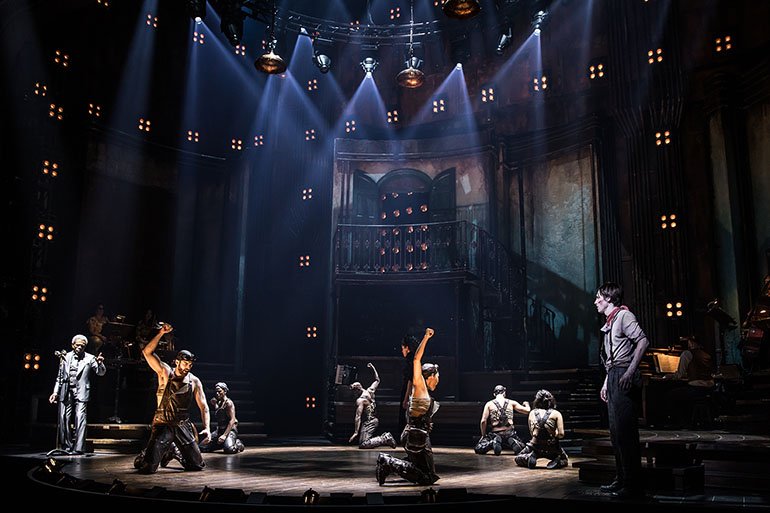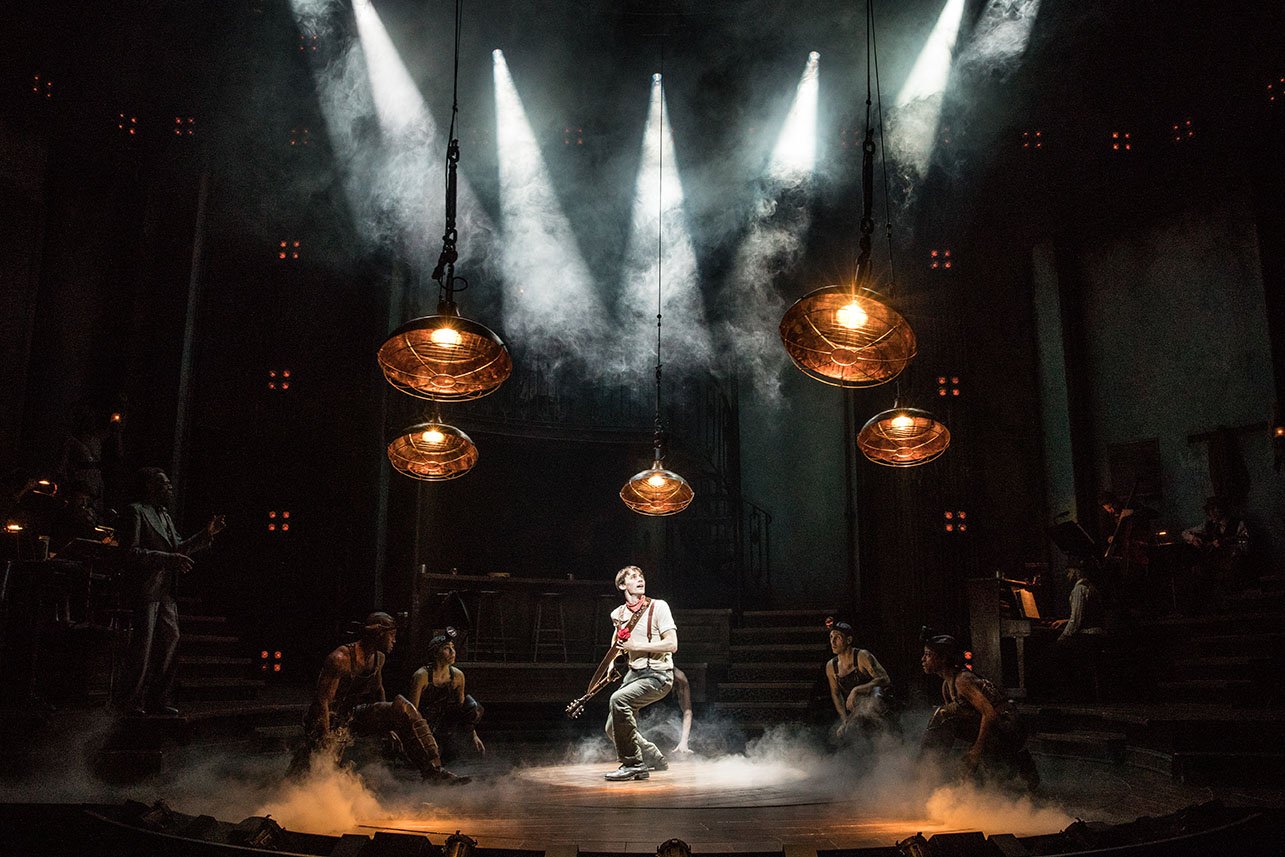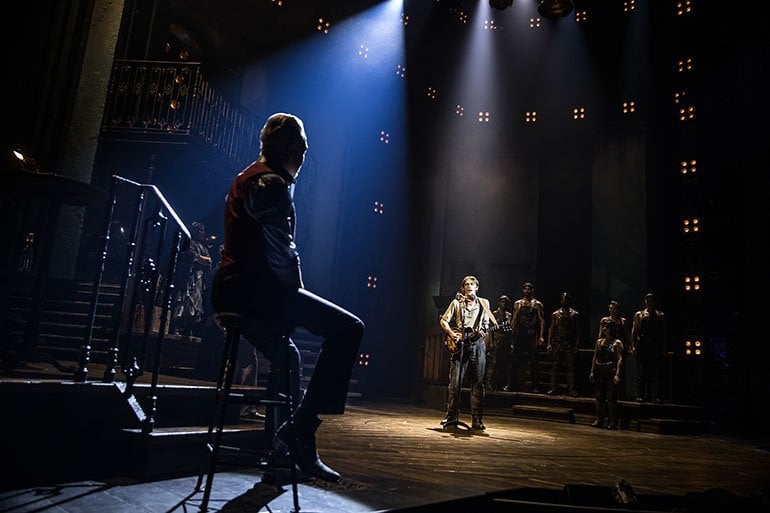The buzz of Broadway, the talk of the town, Hadestown won eight Tony Awards, including one for lighting designer Bradley King. Crowned as 2019’s Best Musical, with additional Tony Awards for director Rachel Chavkin, scenic designer Rachel Hauck, sound designers Nevin Steinberg and Jessica Paz, Hadestown is Tony-winner Anaïs Mitchell’s take on the Orpheus and Eurydice story with a swinging score. Live Design chats with King on his award-winning lighting, for which he also won a Drama Desk Award this year.
Live Design: Your lighting for Hadestown was very colorful and emotional at New York Theater Workshop. How did you revamp, relight, and maintain the emotion for Broadway?
Bradley King: At New York Theatre Workshop, we were still early in our explorations on what kind of piece we had in front of us, and that led us towards leaning heavily into the concert vocabulary of the text. Rachel Hauck’s beautiful in-the-round, Greek amphitheater-inspired seating, a tiny platform with vintage microphones, and that gorgeous organic tree told everyone that they were in a space to first and foremost hear a story told through music. The lighting design embraced the “event” of the show: that led to a rock concert-inspired color palette with a lot of movement and chases to reinforce that vocabulary.
Our next version, at the Citadel Theatre in Edmonton, we went 180º in the opposite direction and really tried to put the piece in a more traditional proscenium frame. Anaïs drastically expanded the book, our scenery became representational (like, actual railroad tracks, grass, and a sky drop), and at first preview, the creative team looked at what we had made and realized it was completely wrong. It was still beautiful, but it was cold, disaffected, and lacked the warmth the show demands. It was in Edmonton we realized that Hadestown is a poetry piece, not a prose piece.
Fortunately, we got to reset in London at the National Theatre, and that’s where we developed 90% of the vocab you see at the Walter Kerr. The shared communal space is back (this time a bar). We have a nod to the concert aspects (the exposed circle truss and the repurposed blinder lights), but the palette is far more restrained. The cuing is still heavily informed by the music; it’s basically just visual composition to match the deep, deep well of Anaïs’ writing. But it’s a more layered, more mature, more nuanced structure than it was three years ago.

LD: Can you talk a little about the architecture of the rig on Broadway? What lighting fixtures are where and why? What are your workhorses?
BK: We have the opposite problem from our time at the National Theatre in London; the Olivier is massive, with a truly cavernous backstage space, and the Walter Kerr is a relative postage stamp. A lot of the scenic pieces take up an incredible amount of overhead depth, so there are really only a few spaces where we could even fit lighting positions. The circular truss that lives over-stage a vista is the backbone of the lighting rig, and that has a complement of Martin MAC Encore Spots and Viper Washes that carve actors out against the background. There’s a long first electric truss that handles onstage crosslight and band washes. Then there are a number of short sticks of truss wedged between various scenic pieces that cover the rest of the stage. There are also a pair of Mac III AirFXs in the grid that do a superb shaft of light down the middle of the space, a pipe of X-Bars that wash the exposed back wall of Hadestown, and of course, the 4-lite blinder units that are embedded in the back and side walls that surround the set.
LD: Color palette and what is it informed by?
BK: It’s very restrained and mostly informed by the emotional journey of the music. The most color in the show appears halfway through Act I when Persephone brings summertime above ground. When she leaves, the whole palette shifts cold and desaturated. Then as we journey underground, we lean heavily into the CTO and red-shifted incandescent of the blinders. Hadestown is very furnace-like: amber, orange, and rust.

LD: Can you describe one or two of your favorite lighting moments, what they look like and what's happening design-wise?
BK: #1—probably everyone’s favorite moment: “Wait for Me,” otherwise known as the song with the swinging lamps. The swinging lamps, by the way, were the first image Rachel Chavkin ever had in mind once she had heard the music many years ago. They’re meant to invoke the idea of headlights from passing cars on a highway. But what I love about the entire sequence is that it’s such a prime example of good design collaboration: every department, from lighting to scenery to automation to music to orchestrations is working in concert to achieve the magical shift to Hadestown. At its core, it is an incredibly simple shift: two walls are pulling apart just three feet to expose a crack. But all of those elements combine to make it so much more.
#2–“His Kiss, the Riot,” which is one of my favorite numbers and also might be one of the most underrated in the show. This is Hades grappling with what to do about Orpheus’ request to take Eurydice back home, and it is delightfully creepy and spooky. I lean heavily into a sickly yellowish CTO for this number, combined with a bit of footlight to really project his shadow up onto the back wall.

LD: What makes this show so powerful for you? It is definitely the powerhouse of the season and resonates strongly for everyone.
BK: We sing sad songs, even knowing they’re sad, even when we know how they end, because hope is how we tear down walls. Hadestown is very much about what you can accomplish when you realize you’re not walking alone, and I think that is incredibly resonant at this particular moment.
LD: What emotional impact do you hope the lighting design will make, and how does it interact with the other designs, especially scenic?
BK: It may sound counterintuitive, especially with some heavy “noticeable lighting” moments like “Wait for Me,” but my hope is that people aren’t really thinking about the lighting design while they’re watching the piece; that it’s tapping into the emotions of the music and heightening them to help further tell the story. That’s what I hope all our design elements are doing, so that a number like “Wait for Me” is a catharsis of story and experience as opposed to noticeable individual lights or set pieces.
Lighting Team Credits
- Bradley King, lighting designer
- John Viesta, associate lighting designer
- Alex Mannix, assistant lighting designer
- Briget Chervenka, programmer
- Jimmy Maloey, Justin Freeman, production electricians
Lighting Gear
Provided by Christie Lites:
- 60 Martin Encore CLD Performance Spot Luminaire 468W
- 15 Martin Viper Wash DX Luminaire 1000W
- 4 Martin MAC III Air FX Wash Luminaire 1500W
- 12 GLP impression X4 BAR 20 Luminaire 560W
- 8 Elation Professional Platinum 7 WASH Luminaire 600W
- 2 Robe BMFL FollowSpot Luminaire 1700W with Robe BMFL Light Master Side / Rear FollowSpot accessory
- 26 ETC Source Four LED Series LUSTR 2 Lighting Fixture
- 44 Chroma-Q Color Force 12 LED RGBA Striplight Fixture
- 4 Chroma-Q Color Force II 72'' LED RGBA Striplight Fixture
- 10 Rosco Braq Cube 4C RGBW @ 20º
- 10 Elation Professional SixPar 200
- 45 ETC Source Four WFL 750W
- 2 ETC Source 4 MFL 375W
- 70 ProCan 4lite Blinder Light @ 4x650W
- 10 ARRI Junior 300 Fresnel BLACK 300w
- 6 Mini10 WorkLight
- 4 MR16 Snub Nose Birdies lamped at 75W EYC
- 2 MDG Atmospheres Haze Machine
- 3 Look Solutions ViperNT Fogger
- 2 MT-Electronic Vario 8 Low Fog Generator
- 2 Martin Jem AF-1 Fan–Variable Speed
- City Theatrical Flocked Short Tophats
- City Theatrical Custom Top Hats and Flocked Short Top Hats
- 1 ETC EOS Ti 24K
- 1 ETC RPU “3” TI 24K
- 1 ETC PUCK Mini Console (will run as clients)
- 2 Hi-Density ETC Sensor Rack of 96 x 2.4kw Dimmers with CEM3 Modules
- 2 City Theatrical Multiverse Transmitter Model 5910
- 2 City Theatrical Show DMX Neo Transceiver 5710M
- 4 City Theatrical Multiverse Node Model 5902
- 14 City Theatrical Show DMX Neo D4 5742M
- 3 City Theatrical 8dbi Panel Antenna Cat# 5633
- 10 City Theatrical #5916 2x0.9amp dimmer
- 2 Motion Labs 96 X 2.4K 208V Power Distro Racks with 16 veam connectors
- 2 Cue light Control 24 ChannelDMX TRINCULO PROSPEROCue Light system
- 8 Doug Fleenor DMX6REL 15a 6xRelay Pack